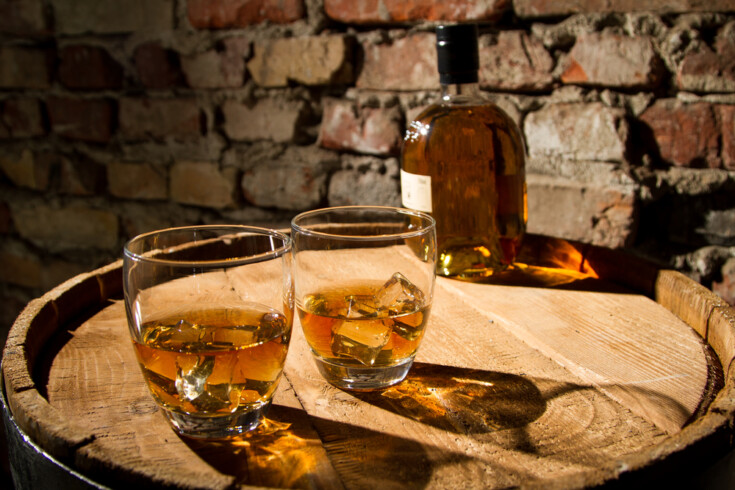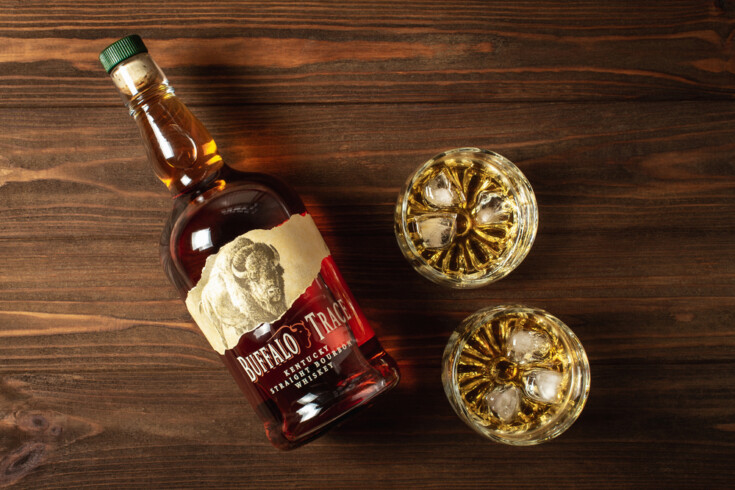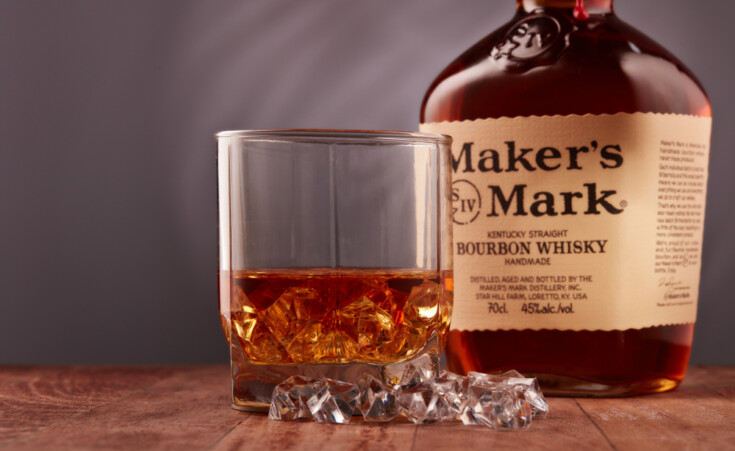
Buffalo Trace and Maker’s Mark are both Kentucky straight bourbons, which means they’re made from at least 51% corn and aged in new, charred oak barrels. However, they have different mash bills (the recipe of grains used) and aging processes, which give them distinct flavors and characteristics. Buffalo Trace, for example, has a higher rye content in its mash bill, which makes it spicier and more complex than Maker’s Mark. On the other hand, Maker’s Mark is known for its signature red wax seal and smooth, sweet taste, which comes from using winter wheat instead of rye in its mash bill.
Buffalo Trace and Maker’s Mark are among the most popular and widely available bourbons in the market, and they both have their own loyal followings. But which one is better? In this article, we’ll compare Buffalo Trace vs Maker’s Mark and help you decide which one to try or buy next.
Table of Contents
History of Buffalo Trace Bourbon Whiskey and Maker’s Mark Bourbon Whiskey
Buffalo Trace Bourbon Whiskey’s History
 photo Editorial credit: NewStart / Shutterstock.com
photo Editorial credit: NewStart / Shutterstock.com
Buffalo Trace Bourbon Whiskey has a long and rich history that dates back to 1773 when the McAfee brothers and Hancock Taylor surveyed the Frankfort area. Two years later, Hancock and Willis Lee established Leestown north of the Frankfort settlement along the Kentucky River, which is now home to Buffalo Trace Distillery. The distillery claims to be the oldest continuously operating distillery in the United States, with a history that spans over 200 years.
The distillery was founded in 1858 by a man called Daniel Swigert, who built a small but functional distillery. In 1870, this building was purchased by Colonel Edmund Haynes Taylor Jr., who transformed it into a state-of-the-art distillery. Taylor was a pioneer in the bourbon industry and is credited with introducing many innovations that are still used today.
During Prohibition, the distillery was forced to shut down like many other distilleries in the United States. However, the distillery was able to survive by producing medicinal whiskey, which was legal during that time. After Prohibition ended, the distillery was purchased by the Blanton family, who ran the distillery until it was sold to the Sazerac Company in 1992.
Maker’s Mark Bourbon Whiskey’s History
 photo Editorial credit: Dmitry Melnikov / Shutterstock.com
photo Editorial credit: Dmitry Melnikov / Shutterstock.com
Maker’s Mark Bourbon Whiskey was founded in 1953 by Bill Samuels Sr. in Loretto, Kentucky. The distillery is known for its iconic red wax seal, which is applied by hand to each bottle.
Samuels Sr. created Maker’s Mark Bourbon Whiskey by using red winter wheat instead of rye in the mash bill. This created a smoother and less spicy bourbon that was popular with consumers. Maker’s Mark Bourbon Whiskey was an instant success and quickly gained a loyal following.
In 1980, Bill Samuels Jr. took over the distillery from his father and continued to expand the brand. In 2014, the distillery was sold to Beam Suntory, a subsidiary of Suntory Holdings, a Japanese beverage company.
Production Process
Buffalo Trace Bourbon Whiskey’s Production Process
When it comes to Buffalo Trace Bourbon Whiskey, the production process involves the following steps:
- Mash Bill: Buffalo Trace uses a mash bill of corn, rye, and malted barley. The exact recipe is a closely guarded secret.
- Fermentation: The mash is fermented in open tanks for three to five days using a proprietary strain of yeast.
- Distillation: The fermented mash is distilled twice in copper stills to produce a high-proof spirit.
- Aging: The spirit is aged in new, charred oak barrels for at least two years. Buffalo Trace uses a unique aging process where the barrels are rotated between warehouses to ensure consistent flavor.
- Blending: Once the barrels have aged, the whiskey is blended to create the final product. Buffalo Trace uses a blend of 25-30 barrels to create its signature taste.
Maker’s Mark Bourbon Whiskey’s Production Process
Maker’s Mark Bourbon Whiskey uses a slightly different production process. Here are the steps involved:
- Mash Bill: Maker’s Mark uses a mash bill of corn, wheat, and malted barley. The wheat gives the whiskey a softer, smoother taste.
- Fermentation: The mash is fermented for three to four days using a proprietary strain of yeast.
- Distillation: The fermented mash is distilled in copper stills to produce a high-proof spirit.
- Aging: The spirit is aged in new, charred oak barrels for at least six years. Maker’s Mark rotates their barrels to ensure consistent flavor.
- Bottling: Once the whiskey has aged, it is bottled at 90 proof.
Taste Comparison
When it comes down to taste, Buffalo Trace and Maker’s Mark have differences. Buffalo Trace has a spicy flavor, while Maker’s Mark is sweeter and smoother. The difference in mash bills is responsible for this contrast. Buffalo Trace is made from a mash that is 10% or less wheat, while Maker’s Mark is made from a mash that is around 70% corn and 16% wheat.
Buffalo Trace has a complex flavor profile due to its aging process. It is aged for at least eight years, which gives it a bolder taste with notes of oak and ripe fruit. On the other hand, Maker’s Mark is aged for six years, which gives it a milder taste with hints of caramel and vanilla.
Both bourbons are great in their own way, but if you prefer a spicier taste, you should go for Buffalo Trace. If you prefer a sweeter and smoother taste, then Maker’s Mark is the way to go.
Price Comparison
When it comes to the price of Buffalo Trace and Maker’s Mark Bourbon Whiskey, there are a few things to keep in mind. First, the price can vary depending on where you live and where you buy it from. Second, both whiskeys are generally considered to be affordable, but one may be a better value than the other.
Maker’s Mark is typically priced around $30 for a 750ml bottle, making it a great value for its quality. On the other hand, Buffalo Trace is slightly more expensive, usually priced around $35 for a 750ml bottle. However, it’s important to note that the price can vary depending on where you live and where you buy it from.
If you’re on a tight budget, Maker’s Mark may be the better choice for you. It’s affordable and offers a smooth, enjoyable taste. However, if you’re willing to spend a little extra, Buffalo Trace is worth the extra few dollars. It offers a more complex flavor profile and is a great choice for those who appreciate a stronger, bolder taste.
Conclusion
Now that you have learned about the differences between Buffalo Trace and Maker’s Mark Bourbon Whiskey, you can make an informed decision about which one to try first.
If you prefer a sweeter taste and a smoother finish, Maker’s Mark may be the best choice for you. On the other hand, if you enjoy a more complex flavor profile with hints of spice and oak, Buffalo Trace might be more to your liking.
Here’s a quick summary of the key differences between the two bourbons:
| Buffalo Trace | Maker’s Mark | |
| Origin | Kentucky | Kentucky |
| Production & Distillation Process | Mash Bill #1 | Wheated Mash Bill |
| Maturation | Charred New Oak Barrels | Charred New Oak Barrels |
| Serving Options | Neat, On the Rocks, or in Cocktails | Neat, On the Rocks, or in Cocktails |
| Bottle Design | Classic | Distinctive Red Wax Seal |
| Tasting Notes | Hints of Spice, Oak, and Vanilla | Sweet, Smooth, and Caramel-like |
Remember, taste is subjective, and what one person likes may not be the same as what you like. So, don’t be afraid to experiment with both and see which one suits your palate the best.
No matter which one you choose, you can be sure that you are getting a high-quality bourbon that is made with care and attention to detail. So, sit back, relax, and enjoy a glass of Buffalo Trace or Maker’s Mark Bourbon Whiskey.



